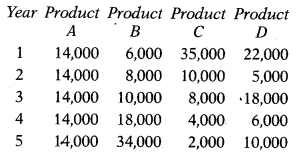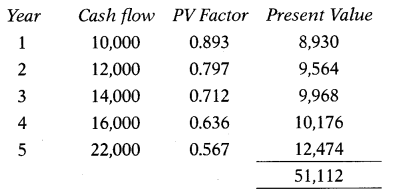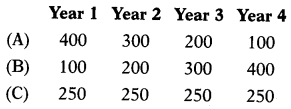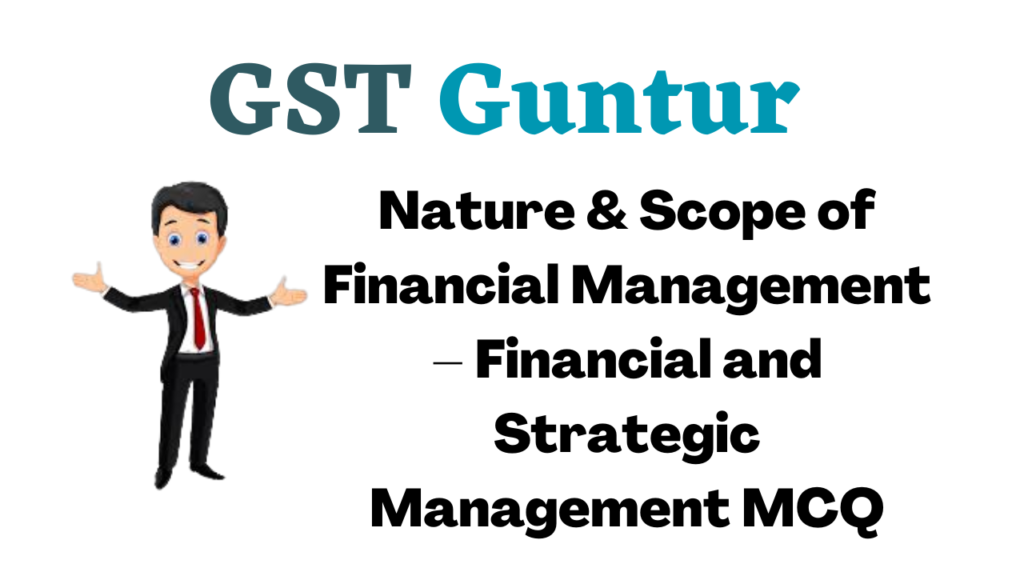Students should practice Nature & Scope of Financial Management – CS Executive Financial and Strategic Management MCQ Questions with Answers based on the latest syllabus.
Nature & Scope of Financial Management – Financial and Strategic Management MCQ
Question 1.
______is the lifeblood of a business.
(A) Finance Manager
(B) Finance
(C) Financial Management
(D) Corporate Financial Management
Answer:
(B) Finance
Question 2.
“Shareholder wealth” in a firm is represented by___
(A) The number of people employed in the firm.
(B) The book value of the firm’s assets less the book value of its liabilities.
(C) The amount of salary paid to its employees.
(D) The market price per share of the firm’s common stock.
Answer:
(D) The market price per share of the firm’s common stock.
Question 3.
Financial Management is study –
(I) Of the process of procuring and judicious use of financial resources
(II) Undertaken to maximize the value of the firm/owners.
Select the correct answer from the options given below.
(A) (I) only
(B) (II) only
(C) Both (I) and (II)
(D) Neither (I) nor (II)
Answer:
(C) Both (I) and (II)
Question 4.
To increase a given present value, the discount rate should be adjusted –
(A) Upward
(B) Downward
(C) Keep as it is
(D) None of the above
Answer:
(B) Downward
Question 5.
The long-run objective of financial management is to___
(A) Maximize earnings per share.
(B) Maximize the value of the firm’s common stock.
(C) Maximize return on investment.
(D) Maximize market share.
Answer:
(B) Maximize the value of the firm’s common stock.
Question 6.
Financial Management is concerned with___
(A) Investment Decisions
(B) Finance Decisions
(C) Dividend Decisions
(D) All of the above
Answer:
(D) All of the above
Question 7.
Procurement of funds inter alia includes___
(a) Identification of sources of finance
(b) Determination of finance mix
(c) Raising of funds
(d) Division of profits between dividends and retention of profits of internal funds generation
Select the correct answer from the options given below.
(A) (a) & (b)
(B) (a), (c) & (d)
(C) (b) & (c)
(D) (c), (a), (d) & (b)
Answer:
(D) (c), (a), (d) & (b)
Question 8.
The market price of a share of common stock is determined by:
(A) The board of directors of the firm.
(B) The stock exchange on which the stock is listed.
(C) The president of the company.
(D) Individuals buying and selling the stock.
Answer:
(D) Individuals buying and selling the stock.
Question 9.
Which of the following is/are the basic aspects of financial management?
(1) Procurement of funds.
(2) Appointment of capable financial personnel.
(3) Effective use of funds to achieve business objectives.
(4) Increase the national resources.
Select the correct answer from the options given below.
(A) (1) & (3)
(B) (2) & (4)
(C) (1) & (4)
(D) (2) & (3)
Answer:
(A) (1) & (3)
Question 10.
The focal point of financial management in a firm is____
(A) The number and types of products or services provided by the firm.
(B) The minimization of the amount of taxes paid by the firm.
(C) The creation of value for shareholders.
(D) The profits earned by the firm.
Answer:
(C) The creation of value for shareholders.
Question 11.
A business organization can obtain funds from –
(A) Issue of preference or equity share capital
(B) Issue of debentures
(C) Loan from banks and financial institution
(D) All of the above
Answer:
(D) All of the above
Question 12.
The decision function of financial management can be broken down into decisions.
(A) Financing and investment
(B) Investment, financing & asset management
(C) Financing and dividend
(D) Capital budgeting, cash management & credit management
Answer:
(B) Investment, financing & asset management
Question 13.
Statement (I):
Since funds can be obtained from different sources, therefore, their procurement is always considered a complex problem by business concerns.
Statement (II):
Funds produced from different sources have different characteristics in terms of risk, cost, and control.
Select the correct answer from the options given below.
(A) Statement I is correct but Statement II is incorrect.
(B) Statement II is correct but Statement I is incorrect.
(C) Statement I & Statement II both are correct and Statement II support Statement I.
(D) Statement I & Statement II both are incorrect.
Answer:
(C) Statement I & Statement II both are correct and Statement II support Statement I.
Question 14.
The funds raised by the issue of____are the best from the risk point of view for the company.
(A) equity shares
(B) debentures
(C) both (A) & (B)
(D) none of the above
Answer:
(A) equity shares
Question 15.
Financial management is –
(A) Science
(B) Art
(C) Both
(D) None
Answer:
(C) Both
Question 16.
A 30-year bond issued by Reliance Ltd. in 2007 would now trade in the –
(A) Primary money market
(B) Secondary money market
(C) Primary capital market
(D) Secondary capital market
Answer:
(D) Secondary capital market
Question 17.
Which of the following is not a function of a finance manager?
(A) Investor relations
(B) Credit & collections
(C) Investments
(D) Appointment of financial personnel
Answer:
(D) Appointment of financial personnel
Question 18.
Money market mutual funds –
(A) Are also known as finance companies
(B) Enable individuals and small businesses to invest indirectly in money-market instruments.
(C) Are available only to high net-worth individuals.
(D) Are involved in acquiring and placing mortgages.
Answer:
(B) Enable individuals and small businesses to invest indirectly in money-market instruments.
Question 19.
Match the following:
| List I | List II |
| (P) Risk Management | 1. Amounts to be retained by the company |
| (Q) Dividend Decisions | 2. Financial planning, controlling & decision making |
| (R) Financial manager’s primary responsibility | 3. Determining the proper amount of funds to be employed |
| (S) Financial Analysis & Planning | 4. Collect data and present the data |
| 5. Protecting assets |
Select the correct answer from the options given below.

Answer:
(A)
Question 20.
The purpose of financial markets is to:
(A) Increase the price of common stocks
(B) Lower the yield on bonds
(C) Allocate savings efficiently
(D) Control inflation
Answer:
(C) Allocate savings efficiently
Question 21.
Investment decisions are concerned with –
(A) Efficient allocation of funds to specific assets
(B) Determining the proper amount of funds to be employed in the firm.
(C) Determining the composition of liabilities
(D) Short-run projects
Answer:
(A) Efficient allocation of funds to specific assets
Question 22.
______ensures that the firm utilizes its available resources most efficiently under conditions of competitive markets.
(A) Wealth Maximization
(B) Profit Maximization
(C) Value Maximization
(D) Relation Maximization
Answer:
(B) Profit Maximization
Question 23.
For which of the following reason(s) profit maximization concept is criticized –
1. It is vague conceptually.
2. It ignores the timing of returns.
3. It ignores the risk factor
4. Its emphasis is generally on short-run projects.
Select the correct answer from the options given below.
(A) 1
(B) 1 & 2
(C) 1, 2 & 3
(D) 1,2, 3 &4
Answer:
(D) 1,2, 3 &4
Question 24.
_____consistent with the object of maximizing the owner’s economic welfare.
(A) Profit Maximization
(B) Wealth Maximization
(C) Relation Maximization
(D) All of the above
Answer:
(B) Wealth Maximization
Question 25.
FinancialManagementis concerned with –
(A) Profit Maximization
(B) Both (A) & (C)
(C) Wealth Maximization
(D) Both (A) & (C) plus Relation Maximization
Answer:
(B) Both (A) & (C)
Question 26.
Assertion (A):
Profit maximization as an objective does not take into account the time pattern of returns.
Reason (R):
The finance managers will accept highly risky proposals if they give high profits by applying the profit maximization concept.
Select the correct answer from the options given below.
(A) Both A and R are true and R is the correct explanation of A.
(B) Both A and R are true but R is not a correct explanation of A.
(C) A is true but R is false
(D) A is false but R is true
Answer:
(B) Both A and R are true but R is not the correct explanation of A.
Question 27.
Profit maximization –
(A) Cannot be the sole objective of a company
(B) Is at best a limited objective.
(C) Has to be attempted with a realization of risks involved
(D) All of the above
Answer:
(D) All of the above
Question 28.
Under inflationary conditions, the value of money expressed in terms of its purchasing power over goods and services
(A) Incline
(B) Declines
(C) Increases
(D) Remains constant
Answer:
(B) Declines
Question 29.
_____is a condition where a company cannot meet or has difficulty paying off, its financial obligations to its creditors, typically due to high fixed costs, illiquid assets, or revenues sensitive to economic downturns.
(A) Financial risk
(B) Financial uncertainty
(C) Financial certainty
(D) Financial distress
Answer:
(D) Financial distress
Question 30.
______means the organization can no longer meet its financial obligations with its lender or lenders as debts become due.
(A) Financial certainty
(B) Financial insolvency
(C) Financial risk
(D) Identified risk
Answer:
(B) Financial insolvency
Question 31.
Assertion (A):
Profit maximization, as an objective is too narrow.
Reason (R):
It ignores the timing of returns and also fails to take into account the social considerations as also the obligations to various interests of workers, consumers, society, ethical trade practices.
(A) Both A and R are true and R is the correct explanation of A.
(B) Both A and R are true but R is not the correct explanation of A.
(C) A is true but R is false
(D) A is false but R is true
Answer:
(A) Both A and R are true and R is the correct explanation of A.
Question 32.
A permanent_____may lead an organization to the chaotic state
(A) Financial insolvency; financial certainty
(B) Financial distress; Identified risk
(C) Identified risk; financial insolvency
(D) Financial distress; financial insolvency
Answer:
(D) Financial distress; financial insolvency
Question 33.
Using _in the capital structure of a company is called financial gearing.
(A) Borrowed funds or fixed cost funds
(B) Owners funds or fixed cost funds
(C) Owners funds
(D) Reserve or balance of profit & loss account
Answer:
(A) Borrowed funds or fixed cost funds
Question 34.
High financial gearing will___
(A) Decrease the EPS of the company if earnings before interest and taxes are rising
(B) Increase the EPS of the company if earnings before interest and taxes are declining
(C) Decrease the EPS of the company if earnings before interest and taxes are declining
(D) Increase the EPS of the company if earnings before interest and taxes are rising
Answer:
(D) Increase the EPS of the company if earnings before interest and taxes are rising
Question 35.
Higher the level of financial gearing___
(A) Greater will be the risk.
(B) Lower will be the risk.
(C) Risk will be constant.
(D) None of the above
Answer:
(A) Greater will be the risk.
Question 36.
Financial management is broadly concerned with___
(A) Raising of funds
(B) Creating value to the assets of the business enterprise
(C) Efficient allocation of funds
(D) All of the above
Answer:
(D) All of the above
Question 37.
Financial Management can be judged by the study of the nature of___
(A) Corporate, social & benefit decisions.
(B) Accounting, financing & dividend decisions.
(C) Personnel, human cost & economic decisions
(D) Investment, financing & dividend decisions.
Answer:
(D) Investment, financing & dividend decisions.
Question 38.
Which of the following is/are a major aspect of the investment decision-making process?
(A) Capital budgeting
(B) Formulation of Functional Strategy
(C) Strategic implementation
(D) All of the above
Answer:
(A) Capital budgeting
Question 39.
Investment decisions encompass___
(A) Cost of capital
(B) Capital budgeting
(C) Management of liquidity and current assets
(D) All of the above
Answer:
(D) All of the above
Question 40.
Optimal investment decisions need to be made taking into consideration such factors as___
(A) Estimation of capital outlays and the future earnings of the proposed project focusing on the task of value engineering and market forecasting;
(B) Availability of capital and considerations of cost of capital focusing attention on financial analysis
(C) A set of standards by which to select a project for implementation and maximizing returns therefrom focusing attention on logic and arithmetic.
(D) All of the above
Answer:
(D) All of the above
Question 41.
If the ‘Profit Maximization’ concept is applied then which of the following Product will be selected?

Note: Above table shows projected earnings of the various products for the next 5 years.
(A) Product A
(B) Product B
(C) Product C
(D) Product D
Hint:
More profit is at Product B; hence it should be selected.
(Profit maximization ignores the timing of returns)
Answer:
(B) Product B
Question 42.
What is the present value factor for 10% at 6 years?
(A) 0.564
(B) 0.683
(C) 0.62 1
(D) 0.513
Hint:
Follow the following steps on the calculator.
Type 1; press ÷ sign; type 1.1; press = sign six time.
Answer:
(A) 0.564
Question 43.
What is the annuity factor for 13% at 5 years?
(A) 2.974
(B) 3.998
(C) 3.517
(D) 3.402
Hint:
Type 1; press ÷ sign; type 1.13; press = sign five time; press ‘GT’ button on calculator.
Answer:
(C) 3.517
Question 44.
Find out the present value of projects cash flow from the following data if the cost of capital of the firm is 12%:
| Year | Cash flow |
| 1 | 10,000 |
| 2 | 12,000 |
| 3 | 14,000 |
| 4 | 16,000 |
| 5 | 22,000 |
(A) ₹ 51,112
(B) ₹ 51,221
(C) ₹ 51,211
(D) ₹ 52,112
Hint:

Answer:
(A) ₹ 51,112
Question 45.
Find out the present value of projects cash flow from the following data if the cost of capital of the firm is 12%:
| Year | Cash flow | PV Factor |
| 1 | 20,000 | 0.893 |
| 2 | 20,000 | 0.797 |
| 3 | 20,000 | 0.712 |
| 4 | 20,000 | 0.636 |
| 5 | 20,000 | 0.567 |
(A) ₹ 1,200
(B) ₹ 2,001
(C) ₹ 2,430
(D) ₹ 2,100
Hint:
Since cash flow for each year is similar annuity factors can be calculated making the total of all PV Factors which comes to 3.605; 20,000 × 3.605 = 72,100.
Answer:
(D) ₹ 2,100
Question 46.
If you invest ₹ 10,000 (P0) m a bank at simple interest of 7% p.a., what will be the amount at the end of 3 (n) years?
Note: Use simple interest rate method
(A) ₹ 12,100
(B) ₹ 15,400
(C) ₹ 17,500
(D) ₹ 20,600
Hint:
Future Value, FVn = Po + SI = Po + Po(i)(n) = 10,000 + 10,000(0.07)(3) = 12,100
Answer:
(A) ₹ 12,100
Question 47.
₹ 2,000 is deposited in a bank for 2 years at a simple interest of 6%. How much will be the balance at the end of 2 years?
Note: Use a simple interest rate method.
(A) ₹ 2,000
(B) ₹ 2,240
(C) ₹ 2,420
(D) ₹ 2,640
Hint:
Required balance is given by
FVn = Po + Po(i)(n) = 2,000 + 2,000 (0.06 × 2) = 2,000 + 240 = 2,240.
Answer:
(B) ₹ 2,240
Question 48.
Find the rate of interest if the amount owed after 6 (n) months is ₹ 1,050 (A), the borrowed amount being ₹ 1,000 (Po).
Note: Use a simple interest rate method.
(A) ₹ 5%
(B) ₹ 10%
(C) ₹ 4%
(D) ₹ 20%
Hint:
We know FVn = P0 + P0(i)(n)
ie. 1,050 = 1,000 + 1,000(i)(6/12)
Or 1,050 – 1,000 = 500(i)
Therefore (i) = 50/500 = 0.10
i.e. (i) = 10%
Answer:
(B) ₹ 10%
Question 49.
Determine the compound interest for an investment of ₹ 7,500 at 6% compounded half-yearly. Given that (1+i)n for = 0.03 and n= 12 is 1.42576.
(A) ₹ 3,193.20
(B) ₹ 3,913.20
(C) ₹ 3,319.20
(D) ₹ 3,139.20
Hint:
i = \(\frac{6}{2 \times 100}\) = 0.03; n = 6 × 2 = 12, P = 1,000
Compound Amount = 7,500(1 + 0.03)12 = 7,500 × 1.42576 = 10,693.20
Compound Interest = 10,693.20 – 7,500 = 3,193.20
Answer:
(A) ₹ 3,193.20
Question 50.
₹ 2,000 is invested at an annual rate of interest of 10%. What is the amount after 2 years if the compounding is done annually?
(A) ₹ 2,420.00
(B) ₹ 2,431.00
(C) ₹ 2,440.58
(D) ₹ 2,442.70
Hint:
The annual compounding is given by:
FV = P (1 + i)n, n being 2, / being 10/100 = 0.1 and P being 2,000
2,000 (1.1)2 = 2,000 × 1.21 = 2,420
Answer:
(A) ₹ 2,420.00
Question 51.
₹ 2,000 is invested at an annual rate of interest of 10%. What is the amount after 2 years if the compounding is done semi-annually?
(A) ₹ 2,420.00
(B) ₹ 2,431.00
(C) ₹ 2,440.58
(D) ₹ 2,442.70
Hint:
For Semi-annual compounding, n = 2 × 2 = 4, i = 0.1/2 = 0.05
FV4 = 2,000 (1 + 0.05)4 = 2,000 × 1.2155 = 2,431
Answer:
(B) ₹ 2,431.00
Question 52.
₹ 2,000 is invested at an annual rate of interest of 10%. What is the amount after 2 years if the compounding is done monthly?
(A) ₹ 2,420.00
(B) ₹ 2,431.00
(C) ₹ 2,440.58
(D) ₹ 2,442.70
Hint:
For monthly compounding, n = 12 × 2 = 24, 7 = 0.1/12 = 0.00833
FV24 = 2,000 (1.00833)24 = 2,000 × 1.22029 = 2,440.58
Answer:
(C) ₹ 2,440.58
Question 53.
Determine the compound interest on ₹ 1,000 at 6% compounded semiannually for 6 years. Given that (1+i) n = 1.42576 for i = 3% and n = 12.
(A) ₹ 1,425.76
(B) ₹ 425.76
(C) ₹ 1452.76
(D) ₹ 542.67
Hint:
i = (6/2) = 3%, n = 6 × 2 = 12, P = 1,000
Compound amount = P (1 + i)n = 1,000 (1 + 3%)12 = 1,000 × 1.42576 = 1,425.76
Compound interest = 1,425.76 – 1,000 = 425.76
Answer:
(B) ₹ 425.76
Question 54.
Ram has taken a 20-month car loan of ₹ 6,00,000. The rate of interest is 12% p.a. What will be the amount of monthly loan amortization?
(A) 33,294.1
(B) 33,249.1
(C) 33,924.1
(D) 32,349.1
Hint:
A = \(\frac{6,00,000}{\mathrm{PVIFA}_{1,20}}=\frac{6,00,000}{18.0456}\) = 33,249.1
Monthly interest =12 per cent/12 = 1 per cent.
Answer:
(B) 33,249.1
Question 55.
What is the present value of 11 to be received after 2 years compounded annually at 10%?
(A) 0.83
(B) 0.91
(C) 0.75
(D) 0.68
Hint:
Here FV = 1, i = 0.1
Required Present Value = FVn (l+i)-n
\(\frac{\mathrm{FV}_{\mathrm{n}}}{(1+\mathrm{i})^{\mathrm{n}}}=\frac{1}{1.1^{2}}=\frac{1}{1.21}\) = 08264 = 0.83
Thus, ₹ 0.83 shall grow to ₹ 1 after 2 years at 10% compounded annually.
Answer:
(A) 0.83
Question 56.
Find out the present value of 12,000 received after in 10 years, if the discount rate is 8%.
(A) 926 N
(B) 1,000
(C) 858 J
(D) 905 c
Hint:
Present value of an amount = FVn\(\left[\frac{1}{1+i}\right]^{n}\)
I = 8%; n = 10 years
2000\(\left[\frac{1}{1+0.08}\right]^{10}\)
= 2,000 (0.463)
= 926
Answer:
(A) 926 N
Question 57.
Find the amount of an annuity if payment of ₹ 500 is made annually for 7 years at an interest rate of 14% compounded annually.
(A) ₹ 5,356.25
(B) ₹ 15,563.52
(C) ₹ 5,365.25
(D) ₹ 5,635.52
Hint:
R = 500, n = 7, i = 0.14
FVA = 500 × FVIFA (7, 0.14) = 500 × 10.7304915 = 5,365.25
Answer:
(C) ₹ 5,365.25
Question 58.
A person is required to pay 4 equal annual payments of ₹ 5,000 each in his deposit account that pays 8% interest per year. Find out the future value of the annuity at the end of 4 years.
(A) 22,535
(B) 22,553
(C) 22,355
(D) 23,255
Hint:
FVA = R\(\left[\frac{(1+\mathrm{i})^{\mathrm{n}}-1}{i}\right]^{n}\)
= 5,000(4.507)
= 22,535
Answer:
(A) 22,535
Question 59.
Assume that the interest rate is greater than zero. Which of the following cash-inflow streams should you prefer?

(D) Any of the above, since they each sum to ₹ 1,000.
Hint:
We have A(n,i) = \(\left[\frac{(1+\mathrm{i})^{\mathrm{n}}-1}{i}\right]^{n}\)
i being the interest rate (in decimal) per payment period over n payment period.
Here, i = 0.06/12 = 0.005, n = 10.
Required amount is given by A = RA (10, 0.005)
= 200 × 10.22
= 2,044.
Answer:
(A)
Question 60.
If 18% is the best risk-free return available, then you would be indifferent to receiving ₹ 100 now or ₹ 118 in one year’s time
(A) Expressed another way the present value of ₹ 100 receivable one year hence is ₹ 118
(B) Expressed another way the present value of? 118 receivable one year hence is ₹ 100
(C) Both are correct
(D) Data given is insufficient
Answer:
(B) Expressed another way the present value of ₹ 118 receivable one year hence is ₹ 100
Question 61.
₹ 200 is invested at the end of each month in an account paying interest of 6% per year compounded monthly. What is the amount of this annuity after the 10th payment? Given that (1.005)10= 1.0511
(A) ₹ 2,404
(B) ₹ 2,044
(C) ₹ 2,440
(D) ₹ 2,004
Answer:
(B) ₹ 2,044
Question 62.
Y bought a TV costing ₹ 13,000 by making a down payment of ₹ 3,000 and agreeing to make an equal annual payment for 4 years. How much would be each payment if the interest on the unpaid amount by 14% compounded annually?
(A) 3,431.71
(B) 3,413.17
(C) 3,134.17
(D) 3,341.71
Hint:
A = \(\frac{6,00,000}{\text { PVIFA }(0.14,4)}=\frac{10,000}{2.914}\) = 3,431.71
Answer:
(A) 3,431.71
Question 63.
Determine the present value of ₹ 700 each paid at the end of each of the next 6 years. Assume an 8% interest.
(A) ₹ 3,263.10
(B) ₹ 3,632.01
(C) ₹ 3,326.01
(D) ₹ 3,236.10
Hint:
As the present value of an annuity of 700 has to be computed. The present value factor of an annuity of 1 at 8% for 6 years is 4.623. Therefore, the present value of an annuity of 700 will be: 4.623 × 700 = 3,236.10
Answer:
(D) ₹ 3,236.10
Question 64.
Ramu wants to retire and receive ₹ 3,000 a month. He wants to pass this monthly payment to future generations after his death. He can earn an interest of 8% compounded annually. How much will he need to set aside to achieve his perpetuity goal?
(A) ₹ 4,94,775
(B) ₹ 4,49,775
(C) ₹ 4,49,577
(D) ₹ 4,47,975
Hint:
R = 3,000
i = 0.08/12 or 0.00667
Substituting these values in the above formula, we get
PVA = \(\frac{3,000}{0.00667}\) = 4,49,775
Answer:
(B) ₹ 4,49,775
Question 65.
Assuming that the discount rate is 7% per annum, how much would you pay to receive ₹ 50, growing at 5%, annually, forever?
(A) 2,500
(B) 5,200
(C) 2,200
(D) 5,500
Answer:
(A) 2,500
Question 66.
ABCL Company has issued debentures of ₹ 50 lakhs to be repaid after 7 years. How much should the company invest in a sinking fund earning 12% in order to be able to repay debentures?
(A) 4.96 lakhs
(B) 4.92 lakhs
(C) 4.98 lakhs
(D) 5.00 lakhs
Answer:
(A) 4.96 lakhs
